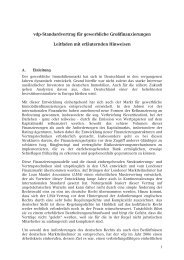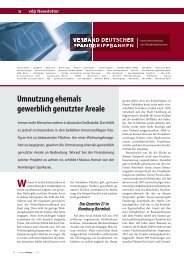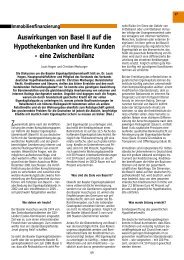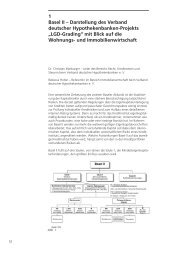The Pfandbrief 2011 | 2012
The Pfandbrief 2011 | 2012
The Pfandbrief 2011 | 2012
You also want an ePaper? Increase the reach of your titles
YUMPU automatically turns print PDFs into web optimized ePapers that Google loves.
Michael Schulz, NordLB; Bodo Winkler, Berlin Hyp; Tanja Stephan, Aareal Bank; Horst Bertram, BayernLB;<br />
Rafael Galuszkiewicz, Münchener Hypothekenbank (from left to right)<br />
BW: If a sizeable volume of house-builders’ loans is still to be found in the cover pools of traditional<br />
mortgage banks, it is either residual holdings or loans that were originated for instance<br />
by respective primary banks of the banking group to which a particular mortgage banks<br />
belongs. Of course, a high level of granularity in the cover pools has a risk-reducing effect.<br />
But granularity is also given when one residential property has many different tenants. <strong>The</strong><br />
percentage of apartments for rent in Germany is traditionally high by European comparison,<br />
particularly in large cities. In the case of purely commercial properties, price developments are<br />
more closely correlated to the macroeconomic situation, albeit with considerable regional differences.<br />
What is ultimately important for the <strong>Pfandbrief</strong> creditor is that the <strong>Pfandbrief</strong> cover is<br />
sufficient to service all <strong>Pfandbrief</strong>e outstanding. Moreover, it is worth bearing in mind the markets<br />
in which the latest crisis arose – it was not the German commercial property market.<br />
59<br />
TS: <strong>The</strong> prime consideration for investors is the stability and sustainability of the <strong>Pfandbrief</strong><br />
issuers’ business models. Models with an emphasis either on residential properties or on commercial<br />
properties are both possible and sustainable. It is important that the issuers have the<br />
necessary expertise for their lending activities, supported by modern portfolio management.<br />
This as a whole helps reduce cover pool volatility. <strong>The</strong> higher volatility in commercial property<br />
finance is already taken into consideration by the calculation of the mortgage lending value,<br />
because the mortgage lending value is determined as the sustainable value of commercial<br />
property, is usually substantially below the market value and is, therefore, also less susceptible<br />
to fluctuation.<br />
5.<br />
Rating or no rating? Rating agencies are placing increasingly greater demands<br />
on overcollateralization as a basis for giving <strong>Pfandbrief</strong>e a top rating. This leads<br />
to larger shares of expensive, uncovered refinancing. How is this trade-off to be<br />
resolved? Is there an answer to the question of the “right” number of ratings?<br />
TS: Ratings and rating agencies lost much of their credibility during the financial crisis;<br />
this cannot be reversed by changing analysis models and refining rating concepts. From the<br />
<strong>Pfandbrief</strong> investor’s viewpoint, besides ratings, the transparency of the cover pools makes for<br />
additional confidence. Nevertheless, ratings are at present an indispensable reference point in<br />
the capital market – for issuers, investors and regulators alike. On the whole, more competi-
















